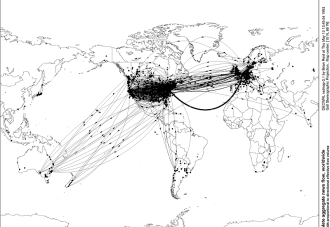In the biblical story of David and Goliath, a young shepherd named David, inexperienced in war and armed only with a slingshot and a few stones, defeated the mighty and heavily armed giant Goliath. Through courage, ingenuity, and faith in his strength, David achieved a victory that seemed impossible.
This ancient story is a powerful metaphor for the modern digital world, where small decentralized platforms, collectively known as the Fediverse, challenge tech giants like Facebook, Instagram, X, YouTube, and others. The Fediverse is a collection of decentralized platforms that allow users to manage their data and interact without the involvement of large corporations.
Like David, the Fediverse lacks significant resources or massive support. However, it offers an alternative to centralized platforms, where users — not corporations — set the rules. Despite its potential, decentralized platforms remain a niche product, primarily appealing to data privacy enthusiasts and advocates of digital freedom.
Can Fediverse platforms become a modern-day digital “David” capable of challenging the “Goliaths” of BigTech? Or will they remain niche platforms for techno-utopians? What obstacles stand in the way of decentralization, and how can they be overcome? These and other questions are explored in the analytical brief prepared by the Center for Democracy and the Rule of Law.
Fediverse Platforms as BigTech Alternatives
The Fediverse brings together more than a hundred diverse decentralized platforms that “communicate” with each other using the same protocol — ActivityPub. Thanks to this shared “language”, users from different platforms can interact seamlessly: send messages, publish and share content, gain followers from various platforms, and more.
A schematic representation of the Fediverse
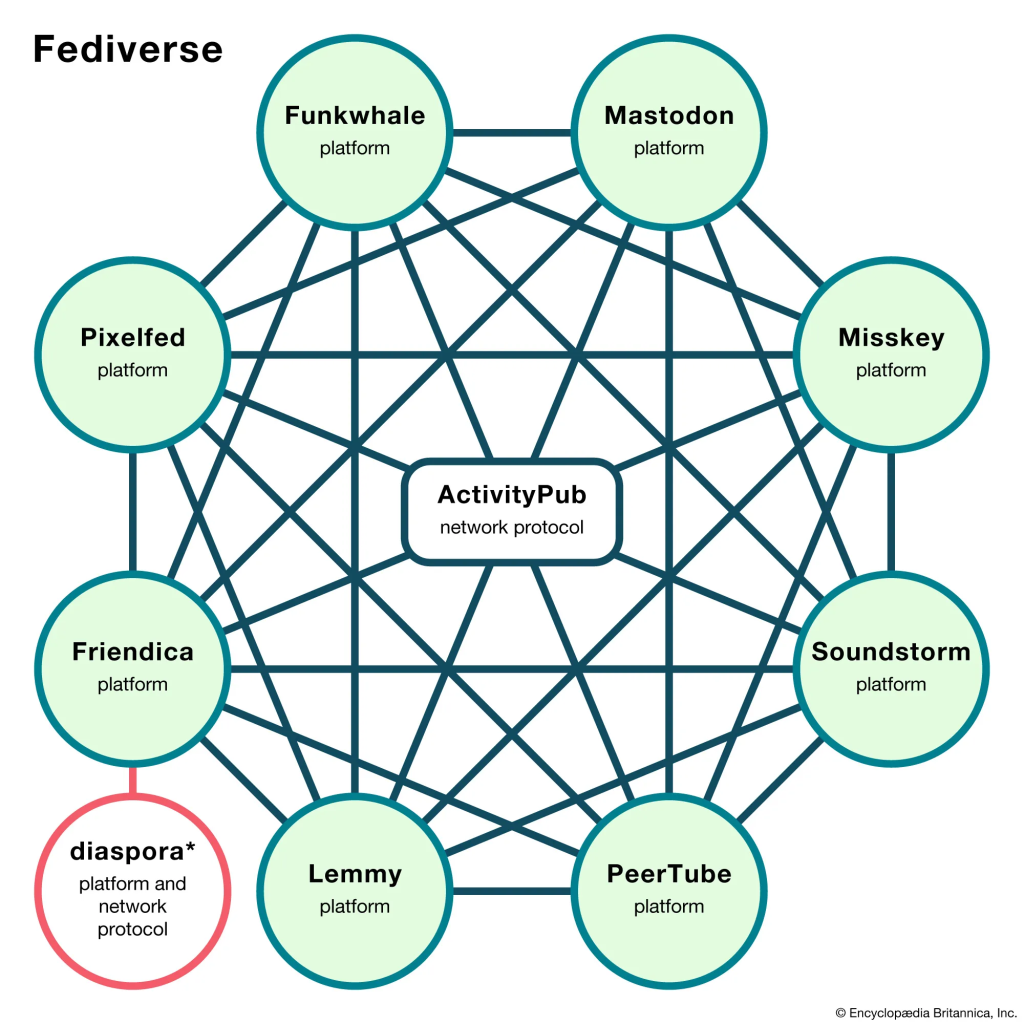
Source: Encyclopædia Britannica
Let’s consider some examples of the most popular Fediverse platforms (both large and small):
1. Mastodon (X/Twitter alternative on the ActivityPub protocol)
Mastodon is the largest federated decentralized social media platform, with around 1.8 million active users per month. It is a typical microblogging platform. In Mastodon, it is possible to create multiple servers (so-called “instances”) specifically for certain communities and dedicated to various interests, fields of knowledge, regions, and types of activities. The platform also has at least nine Ukrainian servers in different cities across the country. Each Mastodon server is like a separate island in a vast archipelago. Each island has its own unique culture, customs, and rules and generally welcomes travelers with shared interests or from the same region. You can choose an island that best suits your preferences and worldview. And if, over time, you wish to change your environment, you can easily move to another island while keeping all your treasures — your followers and important data.
No matter which Mastodon server you choose, you gain access to the platform’s functionality: you can write short messages (typically up to 500 characters), add images, videos, audio, descriptions for images/videos/audio, content warnings, and polls. You can mention other people in the Fediverse in your posts and send private messages. You can use hashtags and find posts based on hashtags.
Unlike X and other large centralized platforms, Mastodon does not have an algorithm that determines what you will see and what you won’t. The feed is displayed in chronological order and is based on what users and groups you follow publish.
The Mastodon interface looks like this:
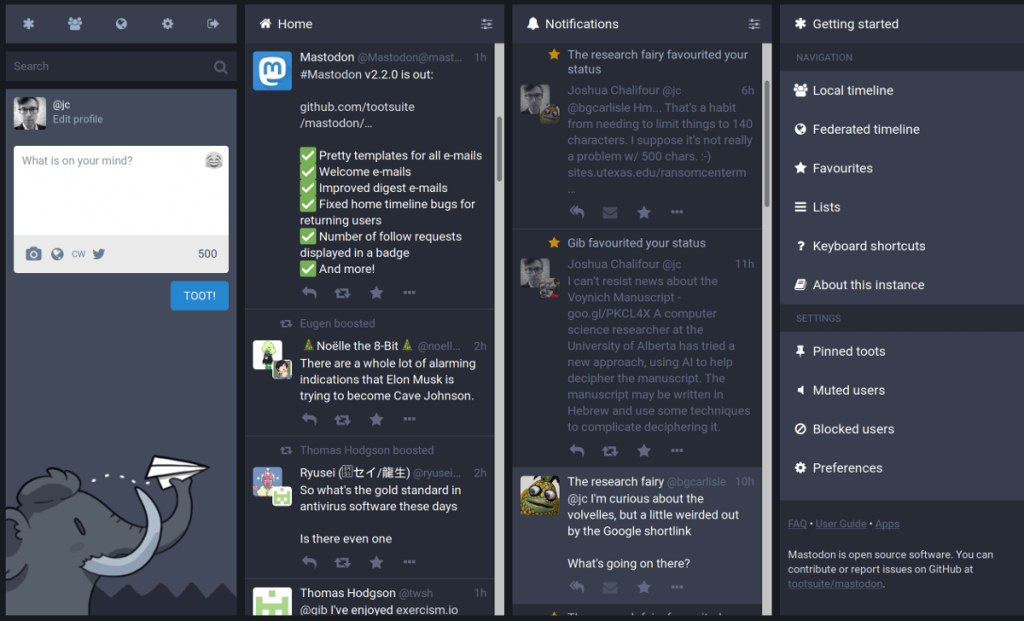
Source: fediverse.party
2. Friendica (Facebook and X alternative on the OStatus, Diaspora, and ActivityPub protocols)
Friendica combines the functionality of Facebook and Twitter. Currently, it has over 4,700 users. You can send private messages, use and track hashtags, mention users and groups, create photo albums and events, like, favorite, and comment on posts, as well as repost them. After publishing, a post can be edited and updated.
Users can also create multiple profiles for their page, allowing different groups of people (for example, friends or colleagues) to see different profiles when viewing the same page.
The Friendica interface looks like this:
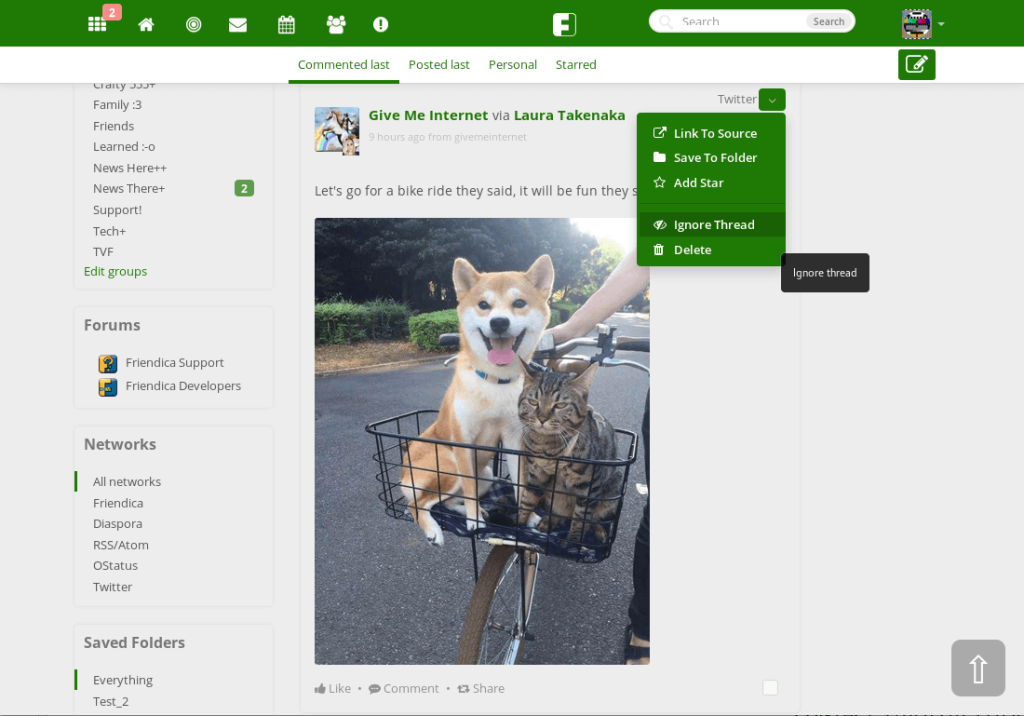
Source: fediverse.party
3. Pixelfed (Instagram alternative on the ActivityPub protocol)
This is a photo-sharing platform with over 63,700 active users. Here, you can post images with any aspect ratio and add captions to them. Your profile will display thumbnails of the images you have uploaded. Depending on your chosen Pixelfed server (instance), you can usually upload 4–8 images in a single post. Captions, tags, location, and visibility settings can be adjusted for each post. You can like and comment on other people’s images. You can also follow people and hashtags.
You can follow not only other Pixelfed users but also users from other Fediverse platforms. Their photo posts will appear in chronological order.
The Pixelfed interface looks like this:

Source: fediverse.party
4. PeerTube (YouTube alternative on the ActivityPub protocol)
This is a video hosting platform with over 10,000 active users. Here, you can upload videos, subscribe to video channels, comment on videos, like, share, and download them. There are no video recommendation algorithms or advertisements.
Video streaming on PeerTube is peer-to-peer (via WebRTC). This means that when other people watch a video on PeerTube at the same time as you, as long as your tab remains open, your browser shares fragments of the video, making the video load faster.
PeerTube has many video hosting providers, and you can choose a host based on the terms of service and moderation policies that suit you. Videos hosted on PeerTube can be watched directly from Mastodon, and this option is expected to be expanded to other Fediverse platforms soon.
The PeerTube interface looks like this:
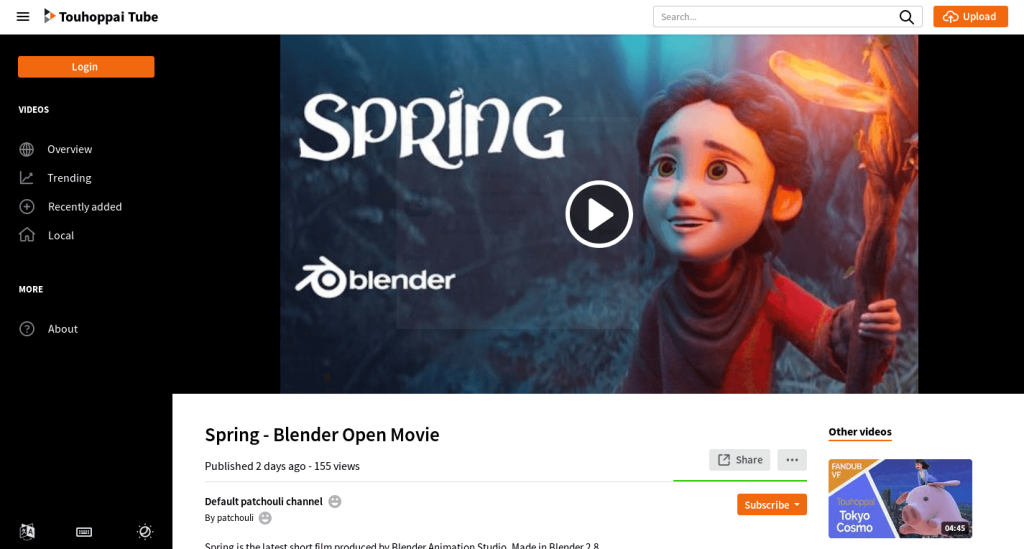
Source: fediverse.party
5. Funkwhale (an alternative to Spotify, Bandcamp, and SoundCloud on the ActivityPub protocol)
This is an audio-hosting platform actively used by over 1,800 people. You can upload your own audio and listen to other artists, various albums, genres, playlists, podcasts, and radio. However, unlike Spotify and other similar major platforms, Funkwhale does not have music from all well-known artists.
At the same time, Funkwhale is more than just an audio server and player. It was also created as a place for discussing music. Additionally, you can follow artists, podcasts, and more from other parts of the Fediverse and subscribe to them.
The Funkwhale interface looks like this:
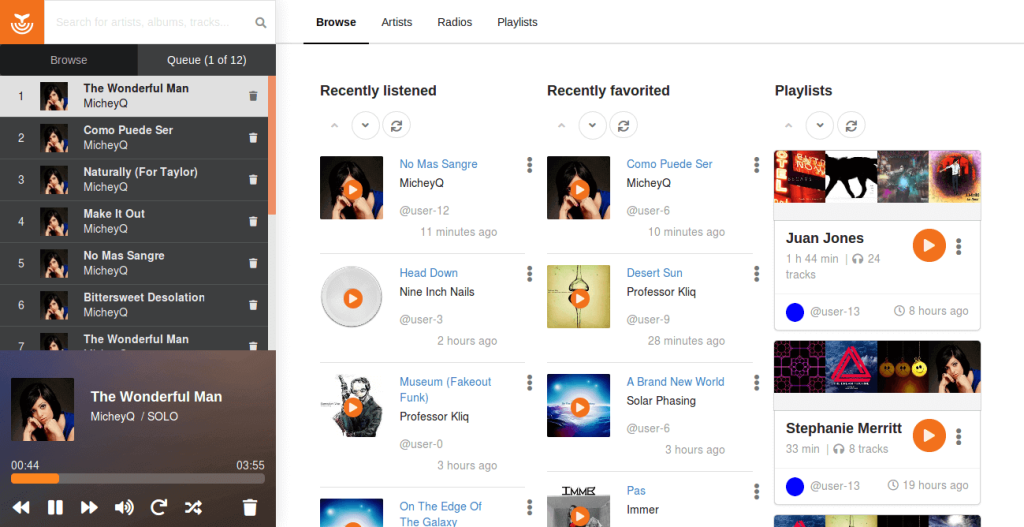
Source: fediverse.party
Interestingly, some BigTech platforms are also considering integrating certain services with the Fediverse. For example, at the end of June 2024, Meta announced the integration of its Threads platform (an alternative to X developed by Meta) into the Fediverse using the ActivityPub protocol.
After extensive development, Meta’s engineers added functionality that allows Threads users to open their profiles and content to users of other Fediverse servers.
Configuring Threads for the Fediverse

Source: Screenshot from the Engineering at Meta page
Threads is not yet fully integrated into the Fediverse, but work on this continues. As of July 2024, Threads had approximately 175 million monthly active users, and this number continues to grow. Given that the total number of Fediverse users currently stands at only 2.1 million, full integration of Threads will significantly increase Fediverse’s metrics.
This will also be an interesting experiment because Threads is not a typical Fediverse platform. While most Fediverse platforms are created as alternatives to BigTech and are developed by small companies with limited resources and altruistic interests, Threads is developed by the BigTech company Meta, which has vast resources, its own private interests, and a business model.
Typical decentralized platforms in the Fediverse have several key characteristics that differentiate them from traditional BigTech platforms:
1. Open and Federated Internet Protocols
BigTech platforms use closed protocols. Decentralized platforms are based on open standards and protocols such as ActivityPub, OStatus, and others. This ensures a high level of technical access to the system and allows anyone to create their own server, configure it as they wish, set their own “rules of the game,” and still remain connected to the broader community.
2. Interoperability Between Platforms
Users of different BigTech platforms cannot interact directly across platforms due to the incompatibility of their closed protocols. Meanwhile, open protocols in decentralized platforms allow different services within the Fediverse to interact with each other. For example, if you use Mastodon, you can follow video content from PeerTube or photos from PixelFed, even if these services are hosted on different servers (instances). This makes the user experience more flexible and allows interaction with diverse content without the need to create separate accounts on each platform.
3. Absence of Surveillance Capitalism
The business model of BigTech platforms is based on monetizing large amounts of user data through targeted advertising. In the Fediverse, each server (instance), whether created within a single platform (such as Mastodon servers) or across different platforms (such as Mastodon, PeerTube, etc.), operates independently. Administrators of each server determine what data to collect and how to use it. In most cases, these servers are not commercially motivated and function through donations, crowdfunding, or user contributions. As a result, such platforms generally do not collect or minimize the collection of user data, do not track users, and do not use their data (likes, comments, etc.) for ad targeting (since there is no advertising at all). Users have more control over their data.
4. Decentralized Data Privacy Protection
BigTech platforms store user data on company servers, meaning cyberattacks on these servers can lead to massive data leaks — something that has happened multiple times. Decentralized platforms have fewer resources to implement advanced security measures, making them potentially more vulnerable to attacks. However, they collect less data and store it across thousands of different servers rather than in a single location. This distributed data storage reduces the risk of massive leaks, as an attack on one server does not grant access to the entire dataset. Additionally, users can choose servers with the best privacy practices or even create their own servers where they control how their data is processed and protected.
5. Decentralized Content Moderation
BigTech platforms set community rules and manage content through algorithms and moderation teams, leading to excessive centralization of power. In the Fediverse, each platform — and more precisely, each server (instance) within each platform (Mastodon, PeerTube, Pixelfed, etc.) — has its own rules and moderation policies. Administrators can decide how to moderate content on their servers, and their decisions do not affect users of other servers in the Fediverse. If users do not agree with the rules of the server they are on, they can switch to another server or create their own with their own rules. When moving to another server, each user can take their followers and previous connections with them. This approach fosters a competitive environment and allows users to choose the server that suits them best.
6. Local Reach with Global Connections
BigTech platforms have a global reach and operate in different legal and cultural contexts. Decentralized platforms can have global connections with other Fediverse platforms and servers, but individual servers (instances) are often tailored to specific communities or regions. Users can choose a server that best matches their cultural and linguistic needs, allowing for better consideration of local specifics. At the same time, thanks to shared open protocols, users from different servers, countries, and cultures can still interact seamlessly.
7. Natural Information Flow
The business model of BigTech platforms is based on the attention economy: they use AI-driven recommendation algorithms and targeted advertising to maximize user engagementretention for increased ad revenue. Decentralized platforms typically do not use complex algorithms to control the flow of information. Content in users’ news feeds is displayed chronologically, ensuring a natural flow of information without external interference or manipulation. Users see posts in the order they were published, reducing algorithmic filtering and preserving diversity of opinion. Moreover, since most decentralized platforms do not rely on advertising revenue, there is no need for excessive content personalization or the promotion of certain posts. This creates a more authentic user experience, where user attention is not exploited for profit. This approach fosters an ecosystem where users have more control over their experience, and community interaction is built on mutual trust and shared interests rather than algorithmic recommendations.
Obstacles to Decentralization: How to Overcome Them?
Along with certain positive aspects, the Fediverse also faces several issues that require increased attention and resolution:
1. Lack of Governance Clarity
Decentralization means that each server (instance) is autonomous and can establish its own moderation rules, but no one is obligated to do so. In such conditions, the responsibility for content governance falls on individual administrators or volunteers working on these servers. The absence of a unified centralized policy and regulatory framework leads to inconsistent moderation quality across different servers.
Since commercial business interests in creating a safe environment in the Fediverse are absent (unlike BigTech, there is no advertising or user data monetization here), some administrators may be motivated by altruistic beliefs and strive to create a safe space. However, this does not guarantee that all instances will adhere to high moderation standards. The availability of resources and the level of professionalism among moderators can also vary significantly between servers. All these factors complicate the creation of an environment with a professional and responsible content moderation process.
One possible solution is to develop a declaration with common fundamental content moderation standards in the Fediverse, as well as recommendations for creating rules and codes of conduct for each server. Server administrators can voluntarily adopt and implement them. This would help preserve the decentralized structure while increasing overall security and accountability.
Additionally, each server should establish well-defined mechanisms for enforcing sanctions for platform rule violations. Users of decentralized platforms who spread hate speech, disinformation, or calls for violence should be held accountable.
2. Lack of Funding
The value of the Fediverse lies in its non-commercial structure. Unlike major social media platforms, decentralized platforms do not have a well-established business model based on user data monetization and advertising. They deliberately avoid collecting and monetizing user data.
However, as the number of users in the Fediverse grows, so do the costs of operation, maintenance, support, and server moderation. Most servers are funded through donations, crowdfunding, or other forms of voluntary user support. This model is unstable and often fails to provide sufficient funding for infrastructure development, server upgrades, or moderator team support. Thus, the question of alternative funding sources arises.
One additional funding source could be a paid subscription. Some servers may adopt a model where users pay a small monthly or annual fee for access to services. This approach would create a more stable revenue stream and reduce dependence on unstable donations. At the same time, such a model must be balanced to avoid deterring users who are unwilling to pay for services. It is important to emphasize the benefits of decentralization, such as the absence of advertising and the preservation of data privacy, to motivate users to support servers financially.
Another potential funding source is support from government and non-governmental organizations. Fediverse servers could receive grants from governmental and non-profit organizations or foundations that support open-source software development and online privacy protection. This could be an important source of funding for platforms aimed at promoting freedom of speech and a decentralized internet. For example, the European Commission has launched the Next Generation Internet initiative, which provides funding for various decentralized platforms. This initiative places a strong emphasis on supporting the Fediverse.
3. Limited Resources
While large centralized platforms like Facebook or YouTube invest enormous resources in content moderation, utilizing advanced AI technologies and large moderation teams, decentralized platforms often lack such capabilities. On decentralized platforms, server administrators (instances) often work on a volunteer basis or have very limited budgets. This can lead to the spread of inappropriate content, hate speech, or disinformation on servers where moderation is absent or ineffective.
One possible solution is the development and implementation of publicly available moderation tools that could be used by various servers in the Fediverse. These could include algorithms for detecting harmful content based on open data, as well as tools for collaborative moderation efforts between moderators from different servers. It is crucial that these tools are accessible even to small servers with limited resources.
Additionally, investing in the training and development of volunteer moderators is essential, as they often handle moderation on decentralized platforms. Organizing workshops, creating online courses, and supporting moderator communities could significantly improve moderation quality. Furthermore, establishing support networks where moderators from different servers can share experiences and assist each other can ease their workload.
4. Lack of Pluralism in the Management of Large Servers (Instances)
Most large servers (instances) are currently managed and moderated by small groups of administrators, often from homogeneous cultural or social backgrounds — primarily white men from Europe and North America. This homogeneity in leadership can lead to the interests and needs of marginalized or underrepresented groups being ignored or misrepresented. This creates the risk that moderation rules will reflect only the views of one segment of society, potentially failing to meet the expectations of other cultural or social groups.
A potential solution to this problem could be initiatives aimed at involving representatives of diverse social, cultural, and ethnic groups in server management processes. This could be achieved through awareness campaigns promoting diversity among server administrators, user surveys (especially from marginalized groups) about content governance on the platform, and grants or other forms of support for launching local servers in regions and communities that are currently underrepresented.
5. The Danger of Servers Created to Spread Radical Ideologies and Hate Speech
The decentralized nature of platforms, which ensures freedom of choice and self-governance of servers, also carries certain risks. One such risk is that anyone can create their own server (instance) — even those who promote radical ideologies, hate speech, racism, or other forms of harmful content. Since servers are independent and can establish their own rules, controlling such servers at the network level is challenging.
A striking example of this situation is the Gab server, initially created on the Mastodon platform as an alternative to traditional social media platforms with a declared focus on free speech. However, this server quickly became a haven for extremists, far-right radicals, and other groups banned on other social media platforms, actively spreading neo-Nazi ideas, hate speech, racism, and disinformation.
To maintain a safe environment, a special agreement between Mastodon servers (Mastodon Server Covenant) was established. It unites only those servers that adhere to certain content moderation and infrastructure security standards. Servers that do not comply with these standards and spread harmful content are isolated from covenant-participating servers.
This “federated blockade”could be one method of combating undesirable servers. Servers that do not wish to engage with hate speech or radical ideologies can refuse interaction with such servers and block them. This means that users from one server will not be able to see content or interact with users from a blocked server.
In addition to self-regulation and server isolation, governments can also influence platforms/servers that spread harmful illegal content. They can use legislative mechanisms to hold individuals accountable for spreading illegal content and, under certain conditions, restrict platforms/servers that significantly violate local laws.
Thus, in the United Kingdom, two teenage neo-Nazis were held accountable for encouraging acts of terrorism, particularly through their posts on the Gab social media platform. They encouraged an attack on Prince Harry for marrying Meghan Markle, a woman of mixed race. Both perpetrators who spread these messages were punished: one received an 18-month detention order, and the other was imprisoned for over four years.
Furthermore, if the activities of platforms/servers violate national legislation, states can issue a decree to ban them. To implement such a ban in practice, states may require the blocking of access to these servers at the level of internet providers or exert pressure on hosting providers to stop servicing such resources. However, the effectiveness of these measures may vary depending on the technical capabilities of the state, available legal mechanisms, and the level of decentralization of the platform. Additionally, when imposing such restrictive measures, states must strike a balance between the right to freedom of expression and the need to combat harmful and dangerous content.
Thus, a combination of server self-regulation and potential actions by state authorities may be effective in combating the spread of harmful content in decentralized platforms.
6. Low Network Effect
One of the key challenges for building a stable user base for Fediverse platforms is the weak network effect. Social media platforms have become an integral part of our lives, not only because of their functional capabilities but also because they allow us to interact with a network of friends, family, and colleagues. We choose a social network not so much because of its technical or ideological features (whether the platform is centralized or decentralized), but because our acquaintances are there. Large social platforms such as Facebook or Instagram have created a powerful network effect: the more people are registered there, the more new users they attract because we want to stay in touch with everyone. In contrast, Fediverse has not yet reached this level of popularity, so there are still few of our friends there, and thus, there is no strong motivation to switch to these platforms. This factor becomes the main obstacle to attracting new users.
To create a powerful network effect, it is important to engage active communities and influential individuals who can help promote decentralized platforms. They could create content about Fediverse, talk about the advantages of decentralized platforms, and even conduct webinars or workshops for new users.
Another solution is to attract niche communities with shared interests or values to decentralized platforms. For example, these could be groups that support ideas of decentralization, privacy, or those with limited access to information on other platforms due to censorship. When these communities find a conducive environment for interaction on Fediverse, they will naturally attract new users from their circles, gradually increasing the network effect.
7. Unfamiliar Interface and User Experience
Another significant problem is the usability of decentralized platforms. Over the years, large centralized platforms such as Facebook, Twitter, or Instagram have meticulously refined their interfaces based on feedback from millions of users. This has allowed them to create an intuitive and user-friendly interface, making the process of using these platforms simple and enjoyable. In the case of Fediverse platforms, the interfaces are not yet as refined and optimized, creating difficulties for new users. They may encounter inconveniences while navigating or setting up their accounts, which deters part of the potential audience.
Addressing this challenge requires a systematic approach: improving the user experience, simplifying the interface, and providing more support for newcomers. This will make decentralized platforms more accessible and attractive to the general public.
One of the first steps in improving the interface is understanding the problems and needs of users. Conducting user experience research, such as surveys and interviews, will help identify the most common difficulties faced by new users. Based on this data, intuitive interfaces can be developed that meet user expectations and minimize the learning curve.
Additionally, new users often find it difficult to navigate unfamiliar interfaces, so it is important to provide them with clear step-by-step instructions. These could include interactive tips during registration, video tutorials, or even specialized bots to help users understand the main functions of the platform. This approach will make the initial experience more comfortable and reduce the percentage of users who leave the platform due to difficulty in mastering it.
Conclusions
Decentralized platforms in the Fediverse embody the principles on which the early Internet was based: openness, freedom, and user self-determination. In a world dominated by BigTech, decentralization offers new opportunities for users, allowing them to take a more active role in shaping their digital experience.
The Fediverse provides users with the freedom to choose servers (or create their own) according to their needs and preferences, as well as greater control over their content and data. These features are especially appealing amid growing concerns about data privacy, increasing distrust toward BigTech giants, and their controversial policies based on monetizing vast amounts of user data and centralized content management.
However, despite these idealistic foundations, decentralized platforms currently face many challenges that cast doubt on their ability to become a full-fledged alternative to major tech corporations in the short term. The main obstacles to their development include a weak network effect and complex interfaces that make it difficult to attract new users. The lack of centralized governance creates risks of platform abuse, such as the creation of servers dedicated to spreading radical ideologies and harmful content. The absence of regulatory clarity, limited resources for content moderation, and overall unstable server funding add to the list of challenges that must be addressed for these platforms to function successfully.
Decentralized platforms have a transformative potential. Their development could fundamentally reshape the digital landscape, shifting power from corporations back to users. In the future, these platforms might become the foundation of a new wave of the Internet — more open, secure, and free from corporate dominance. However, realizing this potential requires significant transformations. This includes not only improving the technical aspects of Fediverse platforms but also shifting societal attitudes toward decentralization as a viable alternative. For now, decentralized platforms remain a niche product, appealing to enthusiasts and privacy advocates, but not yet developed enough to pose a serious challenge to BigTech’s dominance in the short-term future.

